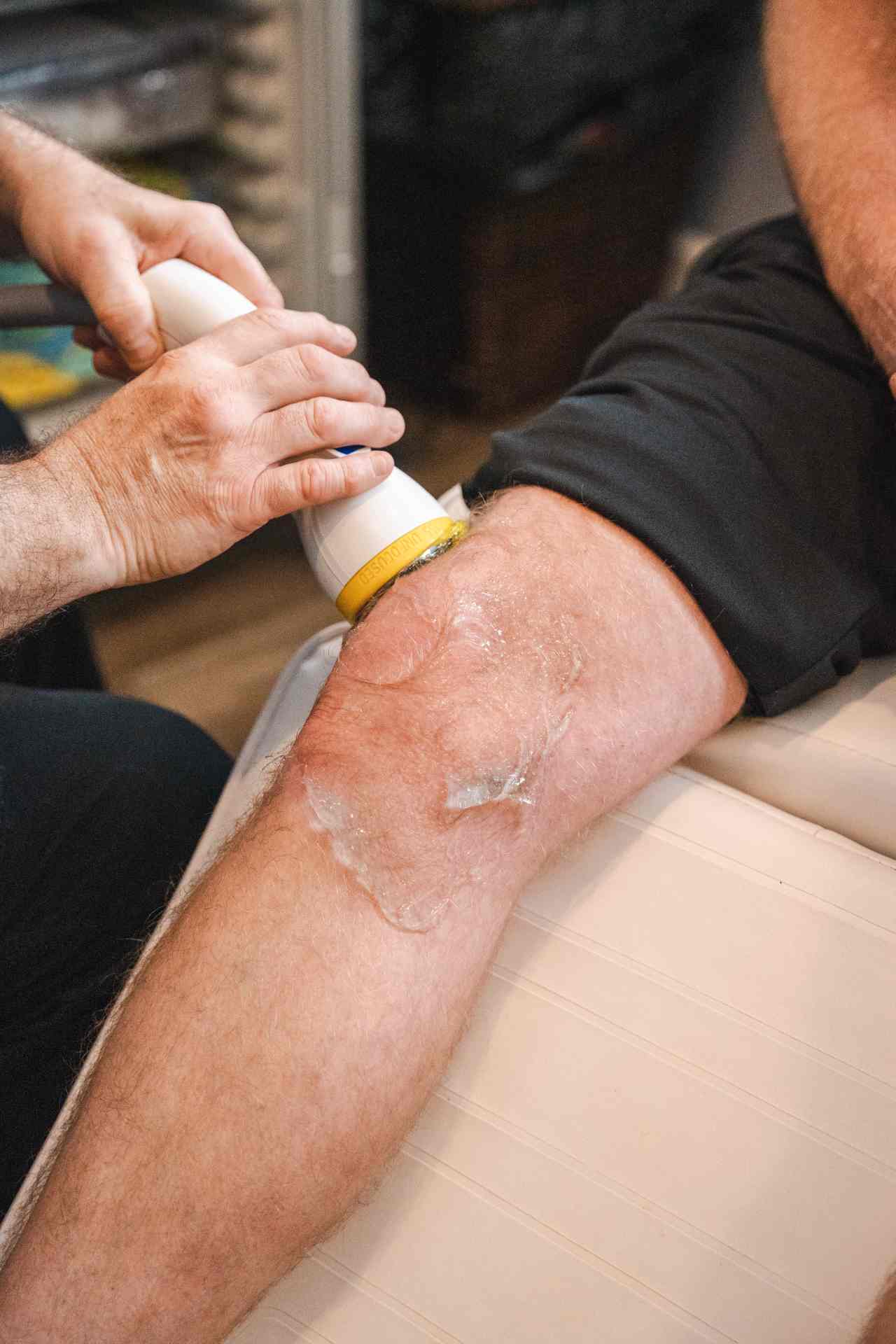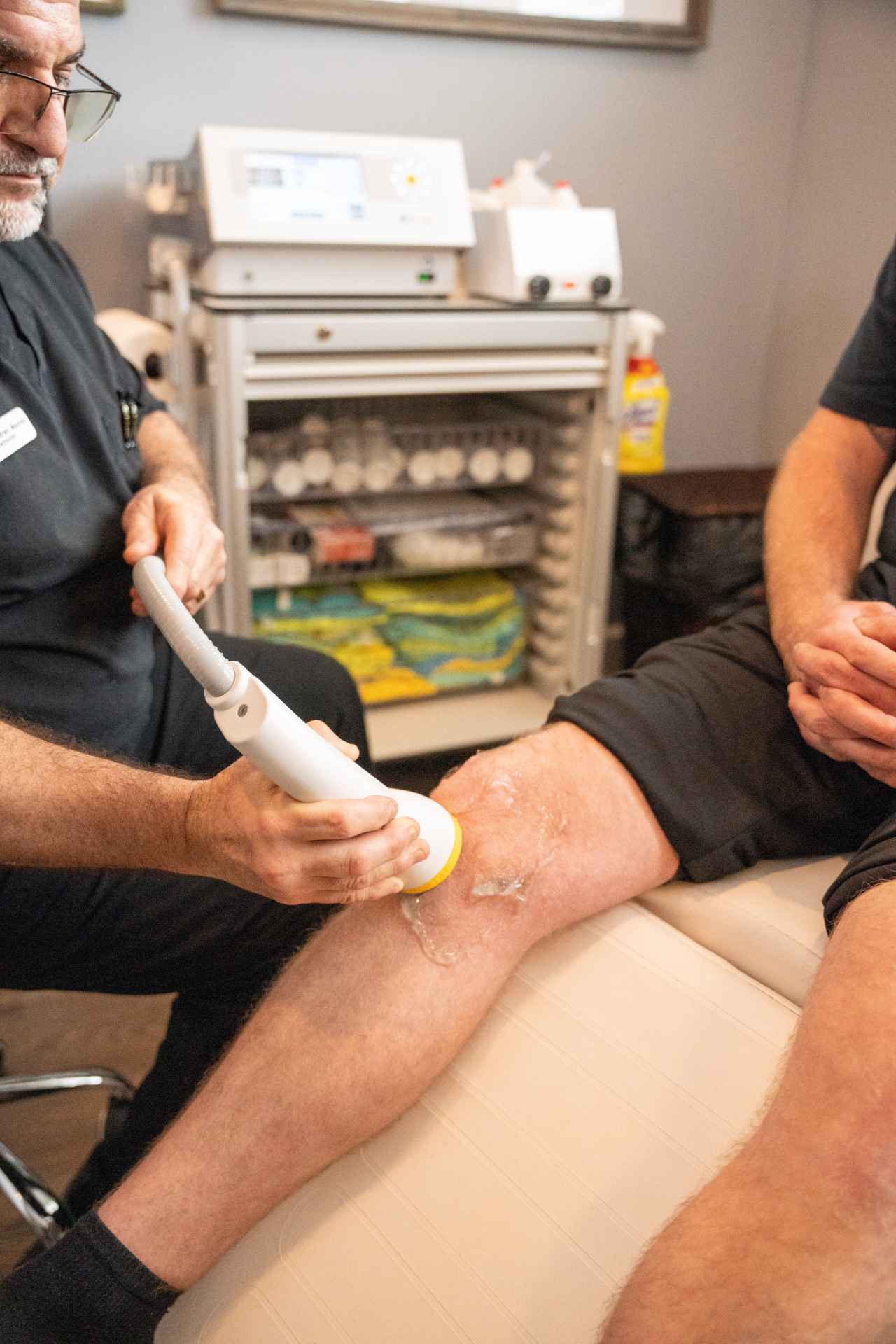If you are dealing with chronic pain or a musculoskeletal condition like plantar fasciitis, tennis elbow, or arthritis, you might be looking for less invasive treatment options. Shockwave therapy offers an alternative to more invasive procedures like steroid injections or surgical intervention while still providing significant relief from pain.
In this post we’ll cover:
- What Is Shockwave Therapy?
- Different Types of Shockwaves
- How Are Shockwaves Generated?
- Radial vs Focused Shockwave Therapy
- High Energy vs Low Energy Shockwaves
- Choosing the Right Shockwave Therapy For You
- The Best Shockwave Therapy for Pain
- FAQs on Shockwave Therapy Types
What Is Shockwave Therapy?

Shockwave therapy is a non-invasive treatment practice that uses high-energy sound waves to stimulate healing and improve function in damaged tissue. This helps reduce pain, jumpstart the body’s healing process, and even helps patients regain mobility.
There are many different types of therapies available that claim to be “shockwave”, but they are not all equal. Each has its own intended uses and benefits.
Here’s everything you need to know about the different types of shockwave technology so you can find one that’s best for your needs.
Different Types of Shockwave Therapy
It’s important to understand that no two types of shockwave therapy are alike. Every shockwave therapy machine has different characteristics that determine what they’re best used for and how effective they are. Types of Shockwave therapy vary according to technology used to produce the shockwave, focused vs broad-focused waves, whether or not the machine produces a true shockwave, energy level, and intensity level.
Considering Shockwave Therapy?
Try SoftWave Therapy for just $69. Non-invasive healing that reaches deeper.

-
Shockwave Therapy Technology
The physical method used to produce the shockwave: The physical method used to produce the shockwave: Different technologies generate shockwaves through various means, including electrohydraulic, electromagnetic, piezoelectric, and radial methods. Each technology serves a unique purpose, catering to different medical conditions and treatment needs. For instance, electrohydraulic generators can be used for both focused and broad-focused shockwaves, such as in SoftWave therapy which produces broad-focused, high-energy, true shockwaves. Electromagnetic and piezoelectric generators are typically used for focused, high-energy treatments, while radial generators are used for broad-focused, low-energy treatments.
-
Focused Vs broad-focused Shockwaves
Focused shockwaves converge at a specific point to deliver maximum energy to a targeted area, making them ideal for treating localized issues like calcific tendonitis or fractures broad-focused waves, on the other hand, disperse energy over a broader area, which can be beneficial for enhancing blood flow and promoting healing in a larger region.
-
Wave Type
True shockwaves are high-energy acoustic waves that create a rapid pressure increase followed by a sudden drop, effectively stimulating tissue repair and pain relief. Technologies like electrohydraulic, electromagnetic, piezoelectric, and SoftWave produce true shockwaves. Pneumatic pressure waves, produced by radial technologies, are less intense and work by dispersing energy in a radial pattern, typically used for surface-level treatment and less effective for deep tissue issues.
-
Energy
Low-energy shockwave therapy is ideal for treating larger, superficial areas, while high-energy shockwave therapy is used for deep, localized conditions requiring more intense treatment. The distinction between energy levels and their applications is critical for effectively targeting and treating various medical conditions.
-
ESWT Vs Li-ESWT
Extracorporeal Shock Wave Therapy (ESWT) and Low-Intensity Extracorporeal Shock Wave Therapy (Li-ESWT) both use shock waves for therapeutic purposes, but they differ in intensity and applications. ESWT utilizes high-energy shock waves, which are effective for breaking down calcified tissues, such as kidney stones, and treating orthopedic conditions due to their focused and powerful acoustic energy. This high intensity allows for deep tissue penetration, making it suitable for localized, deeper-seated conditions.
On the other hand, Li-ESWT employs low-intensity shock waves to promote angiogenesis and enhance the healing process in soft tissues and bones without causing significant tissue damage. Li-ESWT is used for conditions like erectile dysfunction, chronic pain, and musculoskeletal injuries, facilitating cellular regeneration and repair. Its low-intensity waves are ideal for broader therapeutic applications that require stimulating repair mechanisms without extensive trauma, making it a non-invasive option for various medical treatments.
Shockwave Therapy Types Comparison Table
| Technology | Focused/broad-focused | Wave Type | Energy | ESWT/Li-ESWT |
|---|---|---|---|---|
| Electrohydraulic | Focused | True Shockwave | High Energy | High Intensity |
| Electromagnetic | Focused | True Shockwave | High Energy | High Intensity |
| Piezoelectric | Focused | True Shockwave | High Energy | High Intensity |
| Radial | broad-focused | Pressure Wave | Low Energy (not a true shockwave) | Low Intensity |
| SoftWave | broad-focused | True Shockwave | High Energy | Low Intensity |
How Are Shockwaves Generated?

Shockwaves are generated through different mechanisms, each with unique characteristics suited for specific medical applications. These methods include electrohydraulic, electromagnetic, and piezoelectric technologies, which produce focused or radial shockwaves to treat various conditions by stimulating tissue repair, enhancing blood flow, and promoting healing.
Electrohydraulic Shockwave
Shockwave Type: Focused and broad-focused Shockwave Therapy (FSWT)
Best For:
- Pain
- Soft Tissue Injuries
- Musculoskeletal Conditions
- Erectile Dysfunction
- Regeneration Therapy
Electrohydraulic shockwaves, also known as low-intensity extracorporeal shockwave therapy (ESWT), is a medical treatment option that stimulates healing and reduces pain. Linear Li-ESWT uses low-energy shockwaves to promote the healing and regeneration of damaged tissues. This type of shockwave therapy is generally used to treat musculoskeletal conditions like back pain, joint pain, and injuries. During an ESWT treatment session, your healthcare provider will use a specific type of shockwave machine to deliver a series of low-energy shockwaves to the affected area. They will apply the shockwaves to damaged tissue, which then stimulates the production of new blood vessels and proteins, which can help to improve the flow of nutrients and oxygen to the area and speed up the healing process.
Electromagnetic Shockwave
Shockwave Type: Focused Shockwave Therapy (FSWT)
Best For:
- Cancer treatment
- Spinal cord injuries
- Brain tumors
- Uterine Fibroids
Electromagnetic shockwaves are high-energy waves created by an electromagnetic field. In medical settings, electromagnetic shockwaves are often used for treatments such as high-intensity focused ultrasound (HIFU) and radiosurgery. In HIFU, electromagnetic shockwaves are focused on a specific area of the body, such as the prostate gland or the uterus, to heat and destroy abnormal tissue. This type of procedure can be used to treat conditions such as prostate cancer or uterine fibroids. In radiosurgery, electromagnetic shockwaves are used to deliver a high dose of radiation to a specific area of the body, such as the brain or the spine. This can be used to treat conditions such as brain tumors or spinal cord injuries.
Piezoelectric Shockwave
Shockwave Type: Focused Shockwave Therapy (FSWT)
Best For:
- Kidney Stones
- Gall Stones
Piezoelectric shockwave therapy, also known as piezoelectric lithotripsy, is a type of medical procedure that uses focused high-energy shockwaves to break up kidney stones or gallstones. This is a non-invasive procedure often performed on an outpatient basis. During the procedure, a healthcare provider will use an ultrasound or X-ray to locate the stone within the body. A small probe is then placed on the skin over the stone, and a shockwave machine generates a series of high-energy shockwaves. The shockwaves break the stone into small pieces, which allows you to pass it naturally and with minimal discomfort. Piezoelectric shockwave lithotripsy is generally considered to be a safe and effective treatment for kidney stones and gallstones, but it may not be suitable for everyone. Talk to your doctor about the most appropriate treatment option for your specific condition.
Radial Waves
Shockwave Type: broad-focused / Radial Shockwave Therapy (RSWT)
Best For:
- Pain
- Soft Tissue Conditions
- Regeneration Therapy
Radial waves are high-energy pressure waves and technically not a true shockwave according to the International Society for Medical Shockwave Treatment. Radial pressure waves are focused on a specific area of the body to stimulate the production of new blood vessels and collagen. This type of shockwave therapy targets damaged tissues or nerves with radial shockwaves that can be useful for conditions like tendonitis, bursitis, and plantar fasciitis. Radial waves used for shockwave therapy are considered a non-invasive procedure because it does not require an incision or anesthesia.
Radial vs Focused Shockwave Therapy
The key difference between radial and broad-focused shockwave therapy is that radial shockwave therapy produces broad-focused shockwaves over a wider area, while focused shockwave therapy concentrates energy on a precise focal point. This produces different effects and results that yield different pros and cons for each.
What is Radial Shockwave Therapy?
Radial shockwave therapy (RSWT) generates broad-focused shockwaves that radiate out in a 360-degree radius. The shockwaves are applied to a wider surface area, rather than a single focused point. This allows RSWT to treat larger regions of tissue. The pressure waves work by causing microtrauma to the affected area which stimulates the body’s natural healing response.
RSWT is considered less invasive than focused shockwave therapy. It does not require targeting a specific point and is often applied without anesthesia or sedation. It typically utilizes lower energy intensities than focused shockwaves. RSWT is primarily used to treat chronic plantar fasciitis, Achilles tendinitis, and other tendonopathies. It can help reduce pain and improve mobility in these common orthopedic conditions.
What is Focused Shockwave Therapy?
Focused shockwave therapy (FSWT) uses focused shockwaves directed at a precise target point. This type of shockwave is generated using electrohydraulic, electromagnetic, or piezoelectric principles. The waves are focused using geometric lenses to concentrate the energy at a small focal area.
FSWT utilizes higher energy intensities and can reach deeper tissue levels. The focused shockwaves help trigger healing through mechanotransduction, breaking up scar tissue and calcifications. FSWT is often used to treat chronic plantar fasciitis, delayed bone healing, and chronic tendinopathies like tennis elbow. Local anesthesia is typically required due to the higher energy intensities.
Considering Shockwave Therapy?
Try SoftWave Therapy for just $69. Non-invasive healing that reaches deeper.

High Energy vs Low Energy Shockwaves
The term “energy level” in shockwave therapy refers to the total amount of energy delivered per session. Low-energy shockwave therapy employs more diffuse, less concentrated energy suitable for broad, superficial treatments, while high-energy shockwave therapy uses higher energy levels for deeper and more localized treatments. This distinction is crucial for effectively targeting specific medical conditions.
High-Energy Shockwave Therapy
What is High-Energy Shockwave Therapy? High-energy shockwave therapy involves the use of acoustic waves with higher energy levels. These waves can be either focused or broad-focused, depending on the device and application. Focused shockwaves concentrate on a specific point for deep tissue treatment, while high-energy broad-focused shockwaves cover a broader area.
High-energy shockwave therapy is used for:
- Kidney stones
- Non-union fractures
- Severe tendinopathies: such as calcific shoulder tendinitis.
- Bone healing: including delayed union or non-union fractures.
- Spasticity management in neurological disorders
Examples of High Energy Focused Shockwave Machines:
- GAINSwave
- PulseWave
- CuraWave
- Swiss DolorClast
Example of High Energy, broad-focused Shockwave Machines:
- SoftWave (the ONLY true broad-focused shockwave treatment on the market)
Low-Energy Shockwave Therapy
What is Low-Energy Shockwave Therapy? Low-energy shockwave therapy, often associated with radial shockwave therapy (RSWT), involves the use of acoustic waves with lower energy levels. These waves are typically delivered in a more diffuse, radial pattern, making them suitable for treating larger and more superficial areas of the body.
Low-energy shockwave therapy is commonly used to treat:
- Chronic tendinopathies such as Achilles tendinitis and tennis elbow.
- Plantar fasciitis
- Bursitis
- Chronic pain conditions
- Soft tissue injuries
Examples of Low Energy, Radial Shockwave Therapy Machines:
- Storz D-Actor 100-200
- BTL-6000 SWT Topline
- EMS Swiss DolorClast Master
Choosing the Right Shockwave Therapy For You
With all the different types of shockwave therapy available on the market, it can be helpful to do some research and compare the different options to determine which one may be the most suitable for your needs. Some factors to consider when choosing a shockwave therapy include the specific condition you’re treating, the severity of your condition or location of your injury, and the type of shockwave therapy being used.
Most importantly, if you are considering shockwave therapy, it is important to speak with a medical professional to determine the best treatment option for you.
The Best Shockwave Therapy for Pain
Are you looking for safe, reliable, and effective relief from pain caused by soft tissue injuries and conditions?
SoftWave therapy is FDA-cleared, patented, and nationally recognized for its leading tissue regeneration technology. Unlike other types of high-energy shockwave treatments, SoftWave is the only shockwave therapy on the market that uses true broad-focused shock waves that treat larger and deeper areas of tissue.
Thousands of patient’s have experienced the benefits of SoftWave, including:
- Little to no side effects
- Short treatment time
- Quick recovery
- Long-lasting results
Find a provider at a SoftWave clinic near you or learn more about SoftWave and whether or not you’re eligible for full treatment today!
FAQs on Shockwave Therapy Types
-
What is the difference between SoftWave vs Shockwave?
SoftWave is a type of shockwave therapy that uses electrohydraulic shockwaves, which are high-energy and low-intensity. Unlike traditional shockwave therapy that may use focused or radial waves, SoftWave delivers broad-focused shockwaves that treat a broader area and penetrate deeper into tissues. This method is particularly effective for promoting tissue regeneration and healing without causing significant tissue damage. SoftWave therapy is known for its non-invasive nature and ability to stimulate the body’s natural healing processes
-
What’s the difference between Stemwave vs SoftWave?
The main technological difference lies in the type of shockwaves they produce. SoftWave uses electrohydraulic technology to generate broad-focused/parallel shockwaves, which are particularly effective for treating a wide area of tissue without causing microtrauma. In contrast, the Stemwave Modus-F uses electrohydraulic technology to produce focused shockwaves, targeting specific areas within the body for more precise treatment.
-
Can shockwave therapy be combined with other treatments?
Answer: Yes, shockwave therapy can be combined with other treatments to enhance its effectiveness. It is often used alongside physical therapy, medication, or injections to maximize pain relief and promote healing. Combining therapies can provide a more comprehensive approach to treating conditions such as tendinitis, plantar fasciitis, and other musculoskeletal disorders. Always consult with your healthcare provider to determine the best combination of treatments for your specific condition.
-
Are there any side effects or risks associated with shockwave therapy?
Shockwave therapy is considered a safe and non-invasive treatment option, but some patients may experience mild side effects. These can include temporary pain, swelling, redness, or bruising at the treatment site. These side effects are usually short-lived and resolve on their own. Rarely, patients may experience more significant discomfort or complications.
-
What is the typical duration of a shockwave therapy session?
The duration of a shockwave therapy session can vary depending on the condition being treated and the area of the body. Generally, a session lasts between 15 to 30 minutes. Multiple sessions might be needed for optimal results, typically spaced one week apart.
-
Who should avoid shockwave therapy?
Shockwave therapy is generally safe for most people, but it is not recommended for individuals who are pregnant, have blood clotting disorders, or have an active infection at the treatment site. Patients with pacemakers or other implanted devices should also avoid this treatment. Always consult with a healthcare professional to determine if shockwave therapy is suitable for you.
Learn more about Shockwave side effects and contraindications
New Patient Special
Try SoftWave for just $69 at a clinic near you and learn if you’re a candidate for full treatment





